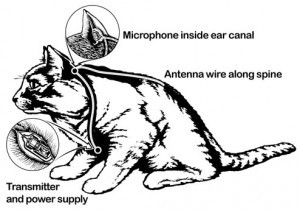The cat’s been out of the bag: the CIA has done some ridiculous experiments.
According to a March 1967 report entitled “Views on Trained Cats [Redacted] for [Redacted] Use,” the CIA stuffed a real, live cat with electronic spying equipment and attempted to train it to spy on America’s Cold War rivals. The report states that Acoustic Kitty (as the project is commonly known) was a “remarkable scientific achievement.” Unfortunately, the report also states that the continued use of live cats as eavesdropping devices “would not be practical.”
According to Victor Marchetti (page 208), who worked as special assistant to the director of Central Intelligence:
“A lot of money was spent. They slit the cat open, put batteries in him, wired him up. The tail was used as an antenna. They made a monstrosity. They tested him and tested him. They found he would walk off the job when he got hungry, so they put another wire in to override that. Finally they’re ready. They took it out to a park and pointed it at a park bench and said, ‘Listen to those two guys…’ They put him out of the van, and a taxi comes and runs him over. There they were, sitting in the van with all those dials, and the cat was dead!”
This cat did not have nine lives.
Alluding to the spy cat’s quality of life with a battery in its stomach and antenna along its spine, Archive fellow Jeffery Richelson commented, “I’m not sure for how long after the operation the cat would have survived even if it hadn’t been run over.”
Acoustic Kitty was developed by the Wizards of Langley at the CIA’s Directorate of Science and Technology. Despite the shortcomings of Acoustic Kitty (and Project Artichoke, while we’re at it), the Wizards of Langley did create many successful Cold War era projects, including the U-2 spy plane and the CORONA spy satellite.
There are many ways to skin a cat, but it’s no surprise that the CIA chose the most expensive. Acoustic Kitty’s price tag was reported to be $15 million.
But despite Acoustic Kitty’s high cost and uselessness for espionage, the CIA report tried its best to present the experiment as a success. It lauded its scientists for being “models for scientific pioneers” because they proved that “cats can indeed be trained to move short distances.”
Curiosity didn’t kill this cat. The CIA did.
Ask me anything
Explore related questions





